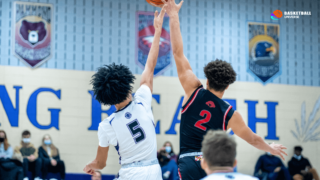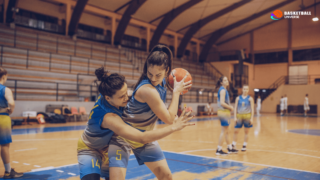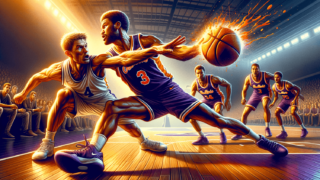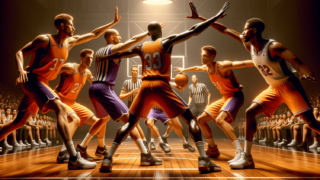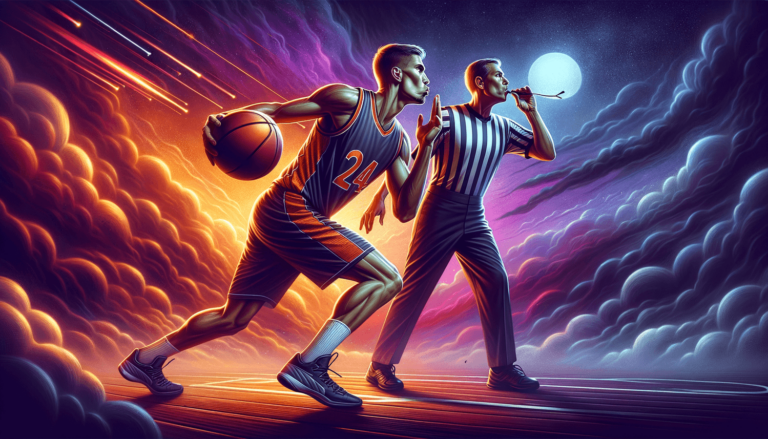
Basketball’s Defensive Foul Rule: What You Need to Know
Written by: Basketball Universe
Last updated:

Get ready to dive into the intriguing world of basketball’s defensive fouls, where knowing the rules is just as important as mastering the perfect jump shot! Contrary to popular belief, defense isn’t just about throwing down blocks and stifling your opponent’s movements. The key to a solid defensive strategy balances the fine line between aggression and legality. In this blog post, we’ll break down the ins and outs of Basketball’s Defensive Foul Rule, providing you with the knowledge necessary to enhance not only your understanding of the game but also your ability to avoid those dreaded whistle blows. So, let’s start our journey through the hardwood court of basketball’s lesser-known realm!
Basketball’s Defensive Foul Rule: What You Need to Know
A defensive foul in basketball occurs when a defending player violates the rules by making illegal contact with an opponent. Such contact can include blocking, holding, pushing, tripping, or striking the offensive player in an effort to impede their progress. The objective of the defensive foul rule is to maintain fair gameplay and discourage overly aggressive defensive tactics. When a defensive foul is committed, the referee typically awards the offensive team a set number of free throws, depending on the severity of the foul and the game situation.
Types of Defensive Fouls in Basketball
To truly grasp the concept of basketball’s defensive foul rule, it’s important to understand the various types of defensive fouls that can occur on the court. As a varied and tactical sport, basketball offers numerous ways for players to commit fouls while defending. In this section, we’ll examine some of the most common defensive fouls you’ll encounter as a fan, player, or spectator.
Blocking Foul
One of the most frequently seen defensive fouls is the blocking foul. This occurs when a defender moves into the path of an offensive player who is either holding the ball or in the process of receiving it, without allowing sufficient time and space for that player to change direction or avoid contact. Essentially, the defender is violating the offensive player’s right to free movement on the court. A key basketball rule to remember is that defenders are required to establish a legal guarding position before making contact with their opponent.
Holding Foul
A holding foul takes place when a defender uses their hands or arms to grab, hold or otherwise restrict an opposing player’s movement, whether they possess the ball or not. The defensive player in this case is unfairly hindering the freedom of movement the game of basketball inherently allows. Remember, basketball rules are built around enabling players to showcase their skills and techniques, so holding fouls are an infringement on this principle.
Pushing Foul
As the name implies, a pushing foul happens when a defensive player pushes an opponent in an attempt to gain an unfair advantage, typically by forcing them off-balance or disrupting their planned actions. Unlike blocking, the pushing foul can occur both while the offensive player has possession of the ball and while they’re without it. A crucial part of mastering the defensive foul rule is learning to avoid making excessive or unnecessary contact with opponents.
Tripping Foul
A tripping foul is committed when a defender uses any part of their body, primarily their legs or feet, to intentionally cause an opposing player to lose their balance and fall. These fouls are particularly dangerous, as they can lead to injury and are therefore taken quite seriously by officials. Always be mindful of your positioning and avoid taking reckless actions that could put others at risk.
Hitting Foul
A hitting foul occurs when a defensive player makes contact with an offensive player in a manner that causes unnecessary harm or discomfort. This includes striking with the hands, arms, elbows or any other body part. In some cases, a particularly violent action might be punished with a Flagrant Foul, which could result in ejection from the game.
The Art of Shot Blocking and Avoiding Fouls
Shot blocking is a valuable defensive skill that can change the course of a game. When executed properly, it can not only deny an opponent from scoring, but can also instill a sense of fear and hesitation in their offensive strategies. However, it is essential for players attempting to block shots to do so without committing defensive fouls.
Legal Shot Blocking
The basketball rules dictate that a shot block is legal when a defender swats or redirects the ball away from the rim after it has left the shooter’s hand, but before it starts its downward trajectory. A key aspect of legal shot blocking is ensuring that contact with the shooter is kept to an absolute minimum. This is primarily done by focusing on timing the jump, maintaining body control, and making a clean play on the ball—rather than the shooter’s hand or arm.
Avoiding Block-to-Foul Scenarios
One of the most common ways defenders commit fouls while trying to block shots is by inadvertently (or purposefully) making contact with the shooter’s hand, arm, or body during the course of the block attempt. To avoid these block-to-foul scenarios, defenders must practice excellent timing and discipline to ensure they don’t fall for pump fakes, which can often lead to contact and subsequent fouls. Defenders should concentrate on contesting the shot effectively without invading the shooter’s personal space or landing area.
Recognizing and Reacting to Offensive Fouls
While our primary focus in this blog post is on defensive fouls, it’s important for players and fans to be aware of—and understand—offensive fouls as well. Being well-rounded in the basketball rules can provide players with the ability to enhance their overall understanding of the game, adapt their strategies accordingly, and ultimately improve their in-game decision-making.
Player Control Foul
A player control foul, also known as a charge, is an offensive foul that occurs when a ball handler makes excessive contact with a stationary defender who has established legal guarding position. Remember that both offensive and defensive players are required to abide by the rules and should respect the rights of their opponents to move and play the game fairly.
Illegal Screen
An illegal screen is considered an offensive foul and occurs when a player sets a screen or pick on a defender without being stationary, typically in an attempt to free up a teammate for a shot or a drive. In these cases, the screener moves or leans into the defender, causing excessive contact and disadvantaging the defending player. It is crucial for screeners to set their position early and avoid movement while executing a pick.
Foul Prevention Strategies
Basketball players can benefit immensely from understanding defensive foul rules as well as developing strategies to avoid committing these fouls. Minimizing foul trouble not only preserves a player’s eligibility to continue participating in the game but ensures a fair contest for all.
Positioning and Anticipation
Good defensive positioning and anticipation are integral to avoiding fouls. By accurately anticipating the offensive player’s movement and intentions, defenders can achieve a legal guarding position and make clean plays on the ball without committing fouls.
Footwork and Agility
Developing exceptional footwork and agility as a defender is necessary for reducing the likelihood of committing defensive fouls. By staying agile and maintaining quick footwork, defenders can remain in front or alongside their opponents while avoiding illegal contact, ensuring they keep their focus on the ball and the offensive player’s actions.
Body Control
Exhibiting body control during defensive play is critical for managing foul risks. Avoid wild, uncontrolled movements that could result in unintentional contact with the offensive player or put them in harm’s way. Instead, focus on maintaining an upright, balanced stance and keeping arms and hands away from the opponent.
Playing Smart and Disciplined
Finally, playing smart and disciplined basketball is essential for keeping foul troubles at bay. Understanding the game situation, recognizing the tendencies of opponents, and having a deep-rooted understanding of the basketball rules will help players make informed decisions, ensuring they always execute their defensive game plan in a clean and efficient manner.
Understanding Free Throws and Penalty Situations
The consequences of defensive fouls often go beyond immediate disruptions in play or changes in possession. Depending on the severity of the foul or the stage of the game, free throw opportunities and penalty situations may arise, impacting the flow and progression of the game.
Free Throws
In most instances, when a defensive foul is committed against a player in the act of shooting, the shooter is awarded two or three free throws, depending on whether they were attempting a two-pointer or a three-pointer. However, fouls committed on non-shooting players during the regular course of play may still result in free throws if the team has reached the “bonus” situation.
Bonus and Double Bonus Situations
A team reaches the bonus situation when its opponent has committed a certain number of team fouls in a period:
- NCAA: Seventh team foul in a half
- NBA: Fourth team foul in a quarter
- International (FIBA) competitions: Fourth team foul in a quarter
In the bonus situation, any defensive foul thereafter, even those committed on non-shooting players, will result in the offensive team being awarded free throws. The specifics of these free throw attempts differ depending on the level of play:
- NCAA: 1-and-1 format, where if the first free throw is made, the shooter gets the opportunity to shoot a second one
- NBA and FIBA: Two free throws for all fouls in the bonus
The double bonus situation only exists in NCAA college play, where after ten team fouls in a half, every subsequent defensive foul results in the fouled team being awarded two free throws, regardless of the success of the first attempt.
Applying Knowledge on the Basketball’s Defensive Foul Rule
Basketball’s defensive foul rule is a critical aspect of the game. With a solid foundation of knowledge regarding the different types of fouls, their consequences, and ways to avoid them, players can be smarter, more effective, and less prone to foul trouble. On the other hand, fans, referees, and coaches can better appreciate and evaluate the game as they watch or guide
impact of Defensive Fouls on Team Dynamics
Defensive fouls not only impact an individual player’s ability to stay in the game, but they also affect the team’s overall performance and dynamics. In this section, we’ll explore some of the ways fouls can influence a team’s strategies, pacing, and cohesion on the court.
Coping with Foul Trouble
When a key player finds themselves racking up fouls, the team must deal with the challenge of foul trouble. Coaches have to decide whether to keep the player on the court or substitute them out, taking into account the risk of further fouls and potentially losing the player for the remainder of the game. This decision can impact the team’s game plan, as well as the chemistry, player rotations, and overall dynamics on the court.
Building Trust and Communication
As a team sport, basketball relies heavily on trust and effective communication between players. Defensive fouls provide the opportunity for teams to learn and grow from their mistakes, encouraging open dialogue and trust-building among teammates. Owning up to fouls and developing strategies to address them can contribute to stronger communication practices and elevate the team’s overall performance.
Influence on Opponents
Defensive fouls can also work to demoralize or disconcert an opposing team—the flip side of gaining an advantage. Clever defensive play can sometimes create scenarios wherein offensive players may commit offensive fouls, be hesitant to attack the basket, or develop a sense of urgency to make plays. By understanding the intricacies of the defensive foul rule, a team can adapt their strategies to exploit the opponent’s weaknesses and capitalize on their mistakes.
Dissecting Personal and Technical Fouls
It is crucial to be aware of the distinction between different categories of fouls within the game of basketball. While we have primarily discussed personal fouls in this blog post, there is another class of fouls that warrant exploration—technical fouls. Understanding both types of fouls is essential for a comprehensive grasp of basketball rules and dynamics.
Personal Fouls
As previously discussed, personal fouls involve illegal contact between players on the court. These fouls directly impact the flow of the game and can result in free throws or changes in possession. Players committing excessive personal fouls may face the risk of fouling out and becoming ineligible to continue playing in the game.
Technical fouls
Technical fouls, on the other hand, are infractions that do not involve physical contact between players but are severe enough to warrant a punishment. Technical fouls are often given to players or coaches for unsportsmanlike conduct, such as protesting a referee’s decision, using inappropriate language or gestures, taunting opponents, or intentionally delaying the game. Technical fouls typically result in one free throw for the opposing team, with possession retained by the team who initially had the ball.
Conclusion
Developing a strong understanding of basketball’s defensive foul rule is essential for anyone involved in the game, from players to referees, coaches, and fans. By comprehending the various types of fouls and the subtleties surrounding their implications, players can improve their performance, reduce the risk of fouling out, and positively contribute to their team’s success. Similarly, coaches, officials, and fans can enjoy a deeper appreciation for the tactical and strategic aspects of the sport, fostering a more enriching and enjoyable experience for all.
Frequently Asked Questions
In this section, we’ve compiled a list of the most frequently asked questions about basketball’s defensive foul rule, providing short and concise answers to help clarify any confusion or curious inquiries you may still have about the topic.
1. What happens when a player commits too many defensive fouls?
When a player commits too many personal fouls in a single game (5 in international/FIBA and college/NCAA, and 6 in NBA), they “foul out” and are ineligible to return to the game.
2. Why are some fouls considered flagrant, and what are the consequences?
Fouls are considered flagrant when they involve unnecessary and/or excessive contact with an opponent. Flagrant fouls are penalized by awarding the fouled player free throws, and the fouling player may be ejected, depending on the severity.
3. What determines if a defensive foul sends the offensive player to the free throw line?
A defensive foul typically results in free throws if the fouled player is in the act of shooting, or if the fouling team has committed enough team fouls to enter the “bonus” situation.
4. How can a defending player avoid committing fouls?
Defenders can avoid committing fouls by maintaining good footwork and body control, adhering to legal guarding positions, anticipating the offensive player’s movements, and playing smart, disciplined basketball.
5. How are fouls assigned to teams, and what is the “team foul” concept?
When a player commits a foul, it is also counted as a “team foul” against their team. Team fouls play a role in determining “bonus” situations, which can lead to free throw opportunities for the opposing team even on non-shooting fouls.
6. What are the consequences of a technical foul?
A technical foul generally results in one free throw for the opposing team, and depending on the severity, it may also result in an ejection of the offending player or coach.
7. How does a referee decide if a block is clean or a blocking foul?
A clean block occurs when a defender swats or redirects the ball away without making contact with the shooter’s hand, arm, or body. A blocking foul occurs if the defender makes illegal contact or fails to establish a legal guarding position before making contact.
8. What is the difference between a defensive and offensive foul?
The key difference is that defensive fouls involve illegal contact committed by the defending team, while offensive fouls involve illegal actions by the attacking team, such as charging or setting illegal screens.
9. Can a defensive foul be called on a player who is not near the ball?
Yes, off-ball defensive fouls can occur when illegal contact is made away from the ball, such as holding or pushing an opponent without the ball, or making contact while setting screens.
10. Are there any specific rules for hand-checking fouls?
A hand-checking foul occurs when a defender uses their hands or arms to impede an offensive player’s movement. The extent to which hand-checking is allowed depends on the level of competition and specific league rules.
Featured Posts
- No pillar pages found.

